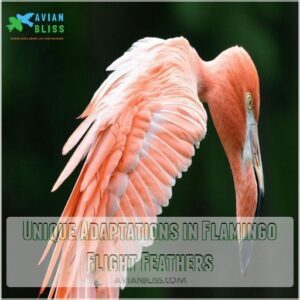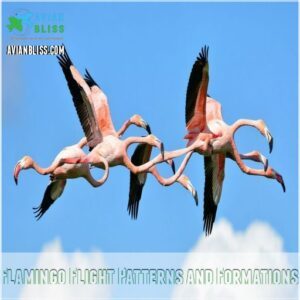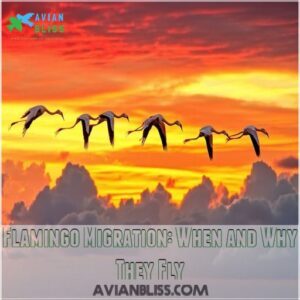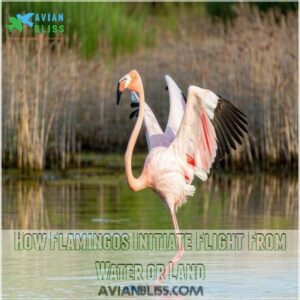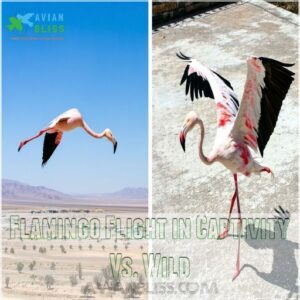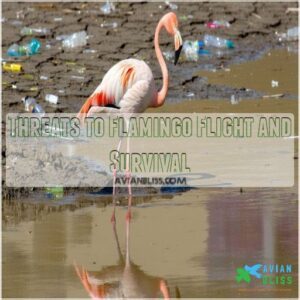This site is supported by our readers. We may earn a commission, at no cost to you, if you purchase through links.

These leggy birds can fly at speeds up to 35 mph and soar to altitudes of 15,000 feet.
While they might look awkward on those stick-thin legs, flamingos are built for long-distance travel, regularly flying hundreds of miles between feeding grounds.
They’re such skilled fliers that even their molting process is specialized – they shed flight feathers gradually to stay airborne year-round.
Only in captivity do they occasionally lose all their flight feathers at once, grounding them for about three weeks.
Their V-formation flights are truly a sight to behold.
Table Of Contents
- Key Takeaways
- Flamingos Flight Capabilities
- Can Flamingos Fly
- Flamingo Wing Structure and Flight Mechanics
- Flamingo Flight Patterns and Formations
- Flamingo Migration: When and Why They Fly
- Flamingo Takeoff and Landing Techniques
- Flamingo Flight Speed and Distance
- Flamingo Flight in Captivity Vs. Wild
- Conservation Efforts and Flamingo Flight
- Threats to Flamingo Flight and Survival
- Frequently Asked Questions (FAQs)
- Can Flamingos Fly?
- What is the flying speed of a Flamingo?
- Are flamingos good flyers?
- Do Flamingos Fly with babies?
- When do Flamingos Fly?
- Why do Flamingos Fly Together?
- Why don’t flamingos fly away?
- Why don’t zoo birds fly away?
- Are flamingos strong flyers?
- Is A flamingo A Flightless Bird?
- What happens when flamingos get sick during flight?
- Do baby flamingos learn flying from their parents?
- How do weather conditions affect flamingo flight paths?
- Can flamingos fly backwards like hummingbirds?
- Do different flamingo species have different flying abilities?
- Conclusion
Key Takeaways
- You’ll find flamingos are skilled flyers that can reach speeds of up to 40 mph and soar at altitudes of 15,000 feet.
- You can observe flamingos flying in V-shaped formations during migration, covering up to 373 miles in a single night to conserve energy and navigate effectively.
- You’ll notice flamingos need a running start to take off, using their long legs to build momentum before lifting into flight with their impressive 165-centimeter wingspan.
- You’ll see that while wild flamingos regularly fly long distances, captive flamingos often have restricted flight capabilities due to space limitations and management practices in zoos.
Flamingos Flight Capabilities
You’ll be amazed to learn that flamingos aren’t just pretty pink statues in the water – they’re actually powerful flyers with wingspans reaching up to 165 centimeters.
You can spot these graceful birds soaring through the skies at speeds of 40 miles per hour, often flying in large groups called "flamboyances" that create stunning V-shaped formations in the air.
Debunking The Flightless Bird Myth
Think flamingos can’t fly? That myth’s been busted!
With a wingspan stretching up to 165 cm and brightly colored flight feathers, these pink beauties take to the sky, leaving the flightless bird myth in the dust.
Using efficient takeoff techniques, flamingos soar in flocks, showcasing bold flight patterns.
They’re not just about standing on one leg!
Unique Anatomical Features of Flamingos
What sets the flamingo apart is its dance of unique features.
Its wingspan folds like a map of the sky; vivid feather colors paint the horizon.
The flamingo’s leg structure acts like stilts, while neck flexibility gives it graceful elegance.
Its distinctive beak shape, a marvel of flight adaptation, scoops success both in air and water.
Here are four key features:
- Wingspan
- Feather Color
- Leg Structure
- Beak Shape
Comparing Flamingo Flight to Other Birds
Now that we’ve looked at flamingos’ unique anatomy, let’s see how their flight stacks up against other birds.
Their wingspan’s pretty impressive, but not as vast as an albatross’s.
Flamingos’ flight efficiency is decent, but their migration strategies differ greatly from, say, geese.
Think of it like comparing a sporty compact car to a luxury sedan – both get you there, but in different ways.
Their takeoff from water is a sight to behold!
Can Flamingos Fly
You might be surprised to learn that contrary to popular belief, flamingos are actually strong flyers.
With the ability to soar up to 40 miles per hour and travel great distances, these pink wonders migrate over vast areas using their impressive wings to navigate the skies.
Average Flight Speed and Distance
Can flamingos fly? Absolutely, they zip through the skies at speeds up to 40 miles per hour for distances reaching hundreds of miles.
Flamingo flight is a marvel of efficiency; their wingspan and strong wing beats make long journeys possible.
When searching for products that match their flight speed, you can find them at Flamingo Flight Products Flamingo Flight Products.
Migration patterns, often influenced by food scarcity cycles, reveal their endurance limits, often covering extensive distances to find resources, blending grace with fuel efficiency in the air.
Maximum Recorded Flight Altitudes
Flamingos, with their impressive wingspan, can soar as high as 20,000 feet.
This altitude isn’t just a feather in their cap; it helps dodge predators and navigate across vast distances.
There’s something comically majestic about these pink birds cruising at altitudes where humans need an oxygen mask.
So next time you see a flamingo, remember, they’re high-flyers!
Factors Influencing Flamingo Flight Patterns
While flamingos reach astounding altitudes, what really shapes their flight patterns?
Imagine you’re a flamingo: food availability, wind conditions, and water levels guide your migration routes, which can cover over 600 km in a single night flight during flamingo bird migration.
Breeding season triggers clockwork-like precision, just as predator threats push you higher.
So, next time you see flamboyances soaring gracefully, remember their flight is a delicate dance influenced by nature’s cues.
Flamingo Wing Structure and Flight Mechanics
You’ll be amazed to learn that flamingos’ impressive wingspan of up to 165 cm helps them soar through the skies at speeds reaching 40 miles per hour.
Their specialized wing structure, complete with 12 primary flight feathers, works like nature’s own aircraft design to generate the perfect lift for these pink frequent flyers.
Anatomy of Flamingo Wings
Nature’s engineering marvel shines through in the intricate design of a flamingo’s wings.
These remarkable appendages showcase:
- A wingspan stretching 95-165 cm, rivaling many birds of prey
- Twelve primary flight feathers with specialized pigmentation
- Dense, water-resistant plumage that’s perfect for both flying and wading
- Flexible wing joints that allow precise control during takeoff and landing
You’ll find their wing structure perfectly adapted for both short hops between feeding grounds and marathon migration flights.
How Flamingo Wings Generate Lift and Thrust
The remarkable wings of these pink waders work like nature’s perfectly engineered aircraft.
When you watch a flamingo take flight, you’ll notice their wings create lift through rapid flapping motions, pushing air downward while generating upward thrust.
Their specialized wing shape helps them slice through the air efficiently, while their impressive wingspan – ranging from 37 to 65 inches – provides the stability needed for sustained flight.
Unique Adaptations in Flamingo Flight Feathers
Among flight-ready birds, flamingos showcase remarkable feather adaptations that’ll make you rethink what you know about avian engineering. Their specialized flight feathers aren’t just for show – they’re precision-crafted tools for aerial mastery.
Their beak morphology and feeding habits are a prime example of filter-feeding birds’ unique adaptations, which also influence their flight capabilities.
- Tough primary feathers span up to 165 cm, rivaling small aircraft wings
- Waterproof coating helps with both flying and wading
- Densely packed barbules create exceptional insulation
- Flexible rachis allows for quick directional changes
- UV-resistant pigments protect feathers during high-altitude flights
Flamingo Flight Patterns and Formations
You’ll often spot flamingos flying in their signature V-shaped formations, where they work together like a well-coordinated aerial team to save energy and navigate more effectively.
These stunning pink birds can soar at impressive speeds of up to 40 miles per hour while maintaining their formation, letting each member benefit from the lift created by the bird flying ahead.
Common Flamingo Flight Formations
Flying high across vast horizons, flamingos showcase remarkable formation patterns during their aerial journeys.
You’ll spot these graceful birds arranging themselves in distinct configurations that vary based on weather conditions and flock size.
| Formation Type | Weather Condition | Typical Size |
|---|---|---|
| V-shaped | Clear skies | 50-200 birds |
| Linear | Strong winds | 20-50 birds |
| Cluster | Stormy weather | 10-30 birds |
Benefits of Flying in Formations
When you spot a V-formation of flamingos soaring overhead, you’re witnessing nature’s brilliant energy-saving strategy.
Their formation flying patterns have inspired designs for various products, such as those found in flamingo v formation gifts.
These pink powerhouses have mastered formation flying, offering four key benefits:
- Up to 25% less energy expenditure through updraft utilization
- Enhanced navigation accuracy during long-distance migration
- Better protection from aerial predators through group vigilance
- Improved flock cohesion with clearer visual signals
Think of it as nature’s carpooling system – smart and efficient!
How Flamingos Coordinate Their Flight Patterns
Flocks of flamingos, like master choreographers, orchestrate their aerial ballet through sophisticated communication and leadership.
Here’s how these pink performers coordinate their V-formation flights:
| Communication Method | Purpose | Notable Features |
|---|---|---|
| Visual Cues | Position Maintenance | Wing tip tracking |
| Vocalizations | Speed Adjustments | In-flight honking |
| Leader Selection | Navigation | Experienced birds lead |
You’ll notice the lead bird switching positions periodically, letting tired leaders fall back while fresh ones take point.
It’s like a perfectly timed relay race in the sky.
Flamingo Migration: When and Why They Fly
You’ll be amazed to learn that some flamingos fly up to 373 miles in a single night, reaching heights of 20,000 feet during their seasonal migrations.
While most flamingos stay put year-round, you’ll find the Andean flamingos making incredible journeys from their frozen high-altitude lakes to warmer lowland waters when winter arrives.
Seasonal Migration Patterns of Flamingos
The incredible journey of migrating flamingos showcases nature’s most fascinating travel plans.
You’ll find these pink wanderers following well-established routes between their breeding and wintering grounds, often stopping at shallow lakes or alkaline waters which provide them with flamingo habitats that support their diet and lifestyle.
Here’s what makes their seasonal migration unique:
- Night flights covering up to 600 km in a single journey
- Altitudes reaching 6,000 meters in the Andes
- V-formation flocks for energy conservation
- Travel distances up to 4,800 km between locations
Factors Triggering Flamingo Migration
Several key factors spark flamingo migration, ranging from environmental shifts to biological imperatives. You’ll notice these graceful birds don’t just take off on a whim – they’re responding to specific triggers that nature has programmed into their DNA.
| Trigger Factor | Primary Impact | Migration Response |
|---|---|---|
| Food Scarcity | Reduced algae growth | Move to nutrient-rich waters |
| Water Levels | Shallow or dry lakes | Seek deeper wetlands |
| Breeding Cycles | Hormone changes | Travel to nesting grounds |
| Temperature Drop | Frozen water bodies | Fly to warmer regions |
| Storm Patterns | Unsafe conditions | Find calmer territories |
Challenges Faced by Flamingos During Migration
Migrating flamingos face tough challenges that would make your daily commute look like a walk in the park.
From dodging hungry eagles at high altitudes to finding their way through increasingly unpredictable weather patterns, these pink wanderers have their work cut out for them.
Habitat loss threatens their traditional rest stops, while climate change disrupts the timing of their journeys.
Food scarcity along migration routes means they’ll need every ounce of energy to complete their incredible voyage.
Flamingo Takeoff and Landing Techniques
You’ll be amazed to watch these graceful giants break into a running start through the water, flapping their massive wings until they catch enough air to lift off.
When it’s time to land, they’ll stretch their long legs forward like landing gear on a pink airplane, using their webbed feet as natural brake pads to slow their descent.
How Flamingos Initiate Flight From Water or Land
Watching flamingos take flight is like seeing ballet dancers prep for a grand jeté.
These graceful birds begin their ascent by wading through water, building momentum as they paddle with their webbed feet.
You’ll notice them breaking into a run, their long legs propelling them forward while their powerful wings start flapping.
This combination of leg strength and wing power creates the perfect lift-off sequence from both water and land.
Flamingo Landing Techniques and Adaptations
You’ll be amazed by how flamingos stick their landings like nature’s own aircraft. Here’s what makes their touchdowns so graceful:
- Their webbed feet spread wide, acting as natural landing gear to absorb impact on both water and land
- Long legs extend forward at a 45-degree angle, creating perfect aerodynamic balance
- Their neck curves into an S-shape during descent, shifting their center of gravity for pinpoint accuracy
Comparing Flamingo Takeoff/Landing to Other Birds
Unlike most birds that spring directly into flight, flamingos need a running start, much like a pink airplane taxiing down a runway.
Flamingos wade through water, gradually picking up speed.
Eagles and hawks use powerful legs to launch upward.
Their distinctive landing style, with legs stretched forward like landing gear, contrasts sharply with the tail-first touchdown of smaller birds.
Flamingo Flight Speed and Distance
You’ll be amazed to learn that flamingos can zip through the skies at speeds up to 40 miles per hour, reaching heights of 13,000 feet above ground.
When they’re in the mood for a long-distance flight, these pink powerhouses can travel up to 373 miles in a single night, often choosing to fly after dark when the air is cooler and calmer.
Average Speed of Flamingo Flight
Swift and graceful, flamingos glide through the skies at impressive speeds that might surprise you.
These pink powerhouses demonstrate remarkable aerial abilities, with scientists documenting their flight capabilities:
- Average cruising speed: 35 mph
- Sprint speed bursts: 40 mph
- Typical altitude speed: 30-35 mph
- Formation flight speed: 32-37 mph
Wind conditions, flock size, and weather patterns all influence their flight speeds, making each journey unique.
Maximum Recorded Flight Distances for Flamingos
These graceful pink travelers are marathon fliers, with Greater Flamingos holding the record for longest flights at up to 4,800 kilometers during migration.
You’d be amazed to learn that they’ve been tracked completing this journey in just a few nights of flying!
Some Andean Flamingos make impressive altitude-based migrations, moving between high-altitude breeding lakes and lower-elevation wetlands when their home waters freeze.
Factors Affecting Flamingo Flight Speed and Distance
While flamingos can cover impressive distances, several factors influence their flight capabilities. You’ll notice their performance varies based on:
- Wind conditions and weather patterns affect their energy expenditure
- Wingspan size directly impacts lift and gliding efficiency
- Body mass determines how much power they need for takeoff
- Flock size influences formation dynamics and energy conservation
- Migration route complexity shapes their speed and stamina requirements
Just like a plane needs ideal conditions for good performance, flamingos adapt their flight strategies based on these environmental and physical factors.
Flamingo Flight in Captivity Vs. Wild
You’ll notice a stark difference between wild flamingos soaring freely at heights of up to 20,000 feet and their captive cousins who often have their wings clipped to keep them in their enclosures.
While wild flamingos can fly hundreds of miles during migration, you won’t see zoo flamingos taking to the skies, though many facilities are now designing larger habitats that allow limited flight opportunities.
Flight Restrictions in Captive Flamingos
After reaching impressive speeds in the wild, captive flamingos face different flight conditions in zoos and sanctuaries. You’ll find varying approaches to managing their flight capabilities, from spacious aviaries to wing-clipping practices. Let’s look at how different facilities handle flamingo flight:
| Facility Type | Flight Management Method | Space Requirements | Exercise Options | Behavioral Impact |
|---|---|---|---|---|
| Modern Zoo | Large Flight Cages | 1000+ sq ft | Natural Flight | Minimal Changes |
| Traditional Zoo | Wing Clipping | 500+ sq ft | Swimming/Walking | Moderate Changes |
| Sanctuary | Mixed Approach | 2000+ sq ft | Limited Flight | Varied Changes |
| Wildlife Park | No Restrictions | 3000+ sq ft | Full Flight | Natural Behavior |
| Research Center | Seasonal Clipping | 1500+ sq ft | Controlled Flight | Studied Changes |
Ethical Considerations of Limiting Flamingo Flight
Limiting flamingo flight in captivity raises critical ethical questions that challenge wildlife professionals and animal advocates alike.
When considering the restriction of these magnificent birds’ natural abilities, several key ethical concerns emerge.
The physical and psychological consequences of caging birds, such as stress, anxiety, and abnormal behaviors like feather plucking, are also pertinent considerations of bird captivity.
- Impact on physical and psychological well-being
- Balance between conservation goals and individual freedom
- Long-term effects on species’ natural behaviors
- Responsibility to maintain genetic diversity
- Trade-offs between public education and animal welfare
These considerations demand thoughtful evaluation of how we manage captive flamingo populations while respecting their inherent need for flight.
Differences in Flight Behavior Between Captive and Wild Flamingos
While studying the unique characteristics of birds like eagles, which often engage in energy conservation through solo flight, reveals the importance of adapting to their environments, observing flight patterns reveals stark differences between captive and wild flamingos. You’ll notice captive birds often display reduced flight activity due to space constraints and modified flock dynamics.
| Behavior | Wild Flamingos | Captive Flamingos |
|---|---|---|
| Flight Distance | Up to 600km nightly | Limited to enclosure |
| Flock Formation | V-shaped patterns | Irregular grouping |
| Exercise Impact | High wing strength | Reduced muscle tone |
Birds like vultures and eagles use thermal soaring to conserve energy, riding columns of rising warm air and often flying in circles to leverage this effect, as seen in the art of thermal soaring tactics. These distinctions highlight how environmental factors shape these magnificent birds’ aerial behaviors.
Conservation Efforts and Flamingo Flight
You’ll be amazed to learn that flamingos can migrate up to 4,800 kilometers between their breeding and wintering grounds, but habitat loss along these routes threatens their survival.
You can help protect these graceful flyers by supporting wetland conservation efforts that preserve their important migration paths and guarantee future generations will witness their spectacular aerial journeys.
Threats to Flamingo Flight and Migration Patterns
You might think flamingos have it easy in the wild, but these majestic pink birds face serious challenges.
Habitat loss has forced them to alter their age-old migration routes, while climate change disrupts their traditional flight patterns.
Fortunately, efforts like Flamingo conservation products help support their well-being.
Pollution in wetlands affects their takeoff spots, and disease outbreaks can ground entire flocks.
The most heartbreaking threat? Poaching continues to thin their numbers, especially during vulnerable migration periods.
Conservation Initiatives Protecting Flamingo Habitats
Conservation warriors worldwide have stepped up their game to protect these majestic birds.
Leading wetland restoration projects are recreating natural flamingo habitats, while innovative pollution control measures keep their waters pristine.
Sustainable tourism initiatives are popping up everywhere, letting visitors admire flamingos’ spectacular flights without disturbing their peace.
Local communities are getting involved too, becoming guardians of these pink-feathered frequent flyers and their precious wetland homes.
Importance of Preserving Flamingo Flight for Ecosystem Balance
Through their extensive flight patterns, flamingos play a key role in maintaining wetland health.
Their migration helps transport nutrients between ecosystems, while their feeding habits control algae populations and maintain water quality.
You’ll find that when flamingos can’t complete their natural flight patterns, entire wetland systems suffer.
It’s like a domino effect – protecting their ability to fly freely helps preserve the delicate balance of these unique ecosystems.
Threats to Flamingo Flight and Survival
You’ll be surprised to learn that these graceful pink birds face serious challenges from habitat loss and climate change, which directly affect their ability to complete essential migration flights.
While you might think predators are their biggest worry, it’s actually human activities like wetland destruction and pollution that pose the greatest threats to flamingo survival and their impressive aerial capabilities.
Habitat Loss and Fragmentation
Witnessing their natural habitats vanish, flamingos face an unprecedented crisis as wetlands are carved up for agriculture and urban development.
Critical wetland conservation has never been more urgent.
You’ll find these magnificent birds struggling to maintain their traditional flight paths as their once-vast territories become fragmented into isolated patches. The disruption affects their ability to reach feeding grounds and breeding sites, forcing them to adapt or abandon historic routes altogether.
Climate Change and Its Impact on Flamingo Migration
Rising temperatures and erratic weather patterns are reshaping flamingo migration in ways you wouldn’t expect. These resilient birds face mounting challenges as climate change disrupts their traditional flight paths and breeding grounds.
Climate change also contributes to habitat loss, a major threat to bird populations, with activities like deforestation and land use changes further exacerbating the issue.
- Shifting wetland conditions force flamingos to alter century-old migration routes
- Unpredictable rainfall patterns threaten the salt flats where they breed
- Extreme weather events can strand entire flocks mid-migration
You’ll find these adaptable birds often flying in a V-formation to reduce wind resistance and conserve energy through upwash zone benefits. Adjusting their flight patterns to survive nature’s new normal.
Human Disturbance and Its Effects on Flamingo Behavior
You mightn’t realize it, but human activities heavily disrupt flamingo behavior in ways that extend far beyond habitat loss.
Noise pollution from nearby airports and tourism hotspots forces flamingos to abandon traditional nesting sites, while excessive foot traffic near feeding grounds disrupts their natural flock behavior.
Even seemingly harmless activities like drone photography can trigger mass flight responses, leading to increased stress and reduced breeding success.
Frequently Asked Questions (FAQs)
Can Flamingos Fly?
Flamingos are impressive flyers, reaching speeds of 40 mph and altitudes up to 20,000 feet during migration. They’ll travel in V-shaped formations called "flamboyances," often covering 373 miles in a single night’s journey.
What is the flying speed of a Flamingo?
These graceful pink birds can reach impressive speeds of up to 40 miles per hour during flight. You’ll often spot them cruising at altitudes between 10,000 to 13,000 feet during their nightly migrations.
Are flamingos good flyers?
Despite what their gawky appearance might suggest, you’d be amazed at their flying prowess.
They’re excellent flyers, reaching speeds of 40 mph and soaring up to 20,000 feet while gracefully maneuvering in V-shaped formations.
Do Flamingos Fly with babies?
Baby flamingos can’t fly alongside their parents during migration.
Nursery groups are formed where the adults leave their chicks, supervised by a few adult caretakers.
This continues until the chicks are strong enough to fly themselves.
When do Flamingos Fly?
Flamingos take flight during their seasonal migrations, typically at night when skies are clear.
Flamingos fly at altitudes up to 20,000 feet, traveling nearly 375 miles in a single nocturnal journey.
Why do Flamingos Fly Together?
By flying together in V-shaped formations, you’ll see these smart birds reducing their energy use, sharing navigation duties, and protecting each other from predators.
It’s a brilliant example of natural teamwork in action!
Why don’t flamingos fly away?
Most often, you’ll find these pink beauties sticking around because they’ve got everything they need: food, friends, and familiar wetlands.
They’re not trapped – they’re just living their best life in their chosen home!
Why don’t zoo birds fly away?
Zoo birds typically stay because they’ve been raised in captivity and don’t have the same survival instincts as wild birds.
Plus, clipped wings and enclosed habitats guarantee they remain safe and well-cared for.
Are flamingos strong flyers?
Flying at speeds up to 40 mph and reaching altitudes of 13,000 feet, flamingos are impressive aerial athletes. You’ll find they’re powerful enough to migrate 373 miles in a single night using V-formations.
Is A flamingo A Flightless Bird?
Despite their long legs and graceful appearance, flamingos are skilled flyers.
You’ll find these pink beauties soaring at impressive heights up to 20,000 feet, reaching speeds of 40 mph during their nighttime travels.
What happens when flamingos get sick during flight?
Sick flamingos will land at the nearest suitable wetland to rest and recover.
They’ll rejoin their flock once they’re better, but if they can’t find proper habitat, they might face serious health risks.
Do baby flamingos learn flying from their parents?
Young flamingos watch their parents closely, mimicking their movements and practicing wing flaps before their first flight.
They’ll take short practice flights near their nests before joining the flock’s aerial adventures.
How do weather conditions affect flamingo flight paths?
Picture a flock of flamingos diverting their path when storm clouds loom.
You’ll find these birds adjusting their flight paths based on wind direction.
They avoid storms and seek tailwinds for energy-efficient long-distance travel.
Can flamingos fly backwards like hummingbirds?
Unlike hummingbirds, flamingos can’t fly backwards.
Their wing structure and flight mechanics only allow forward movement.
Though they’re excellent at soaring through the skies at impressive speeds up to 40 miles per hour.
Do different flamingo species have different flying abilities?
While massive Greater Flamingos soar effortlessly across continents, smaller Andean Flamingos excel at high-altitude flight.
While many birds have developed unique adaptations for nocturnal flight patterns, each species has adapted its flight abilities to match their unique habitats and migration patterns.
Conclusion
Like graceful ballerinas of the sky, flamingos continue to amaze scientists and nature enthusiasts with their remarkable flying abilities.
Flamingos fly, but they’re also impressive aerial performers, capable of covering vast distances at speeds up to 35 mph.
Whether you spot them soaring at breathtaking heights of 15,000 feet or gliding in their signature V-formations, these pink aviators prove they’re more than just pretty birds standing on one leg.
Their flying prowess remains a strong indicator of nature’s incredible design.





